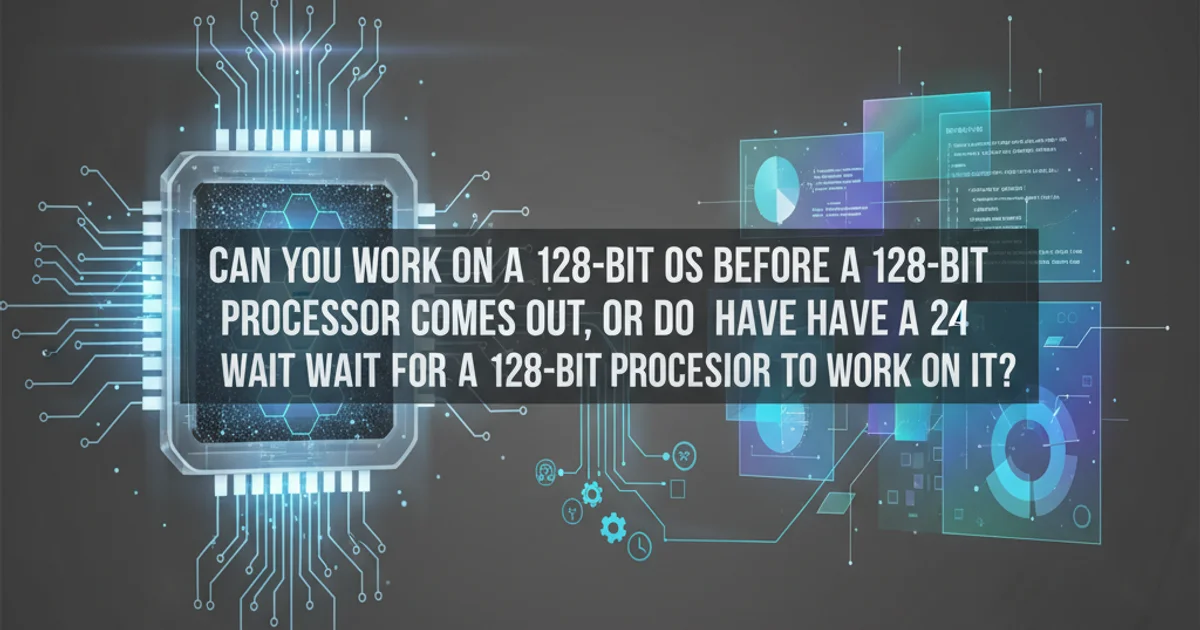Can you work on a 128-bit OS before a 128-bit processor comes out, or do you have to wait for a 1...
Categories:
The 128-bit Computing Myth: OS Before Processor?

Explore the realities of 128-bit operating systems and processors, debunking common misconceptions about their development and interdependence.
The idea of a '128-bit operating system' often sparks curiosity, especially when considering the current prevalence of 64-bit architectures. Many wonder if it's possible to develop or run a 128-bit OS before a corresponding 128-bit processor is available. The short answer is that the concept of a '128-bit OS' in the same vein as 32-bit or 64-bit is largely a misunderstanding of how these architectures evolve and what 'bitness' truly signifies in modern computing.
Understanding 'Bitness' in Computing
When we talk about a '32-bit' or '64-bit' processor and operating system, we are primarily referring to the size of the memory addresses and general-purpose registers that the CPU can handle natively. This directly impacts the amount of RAM an OS can address and the size of data chunks it can process efficiently. For example, a 32-bit system can address up to 4GB of RAM, while a 64-bit system can theoretically address an astronomical amount (16 exabytes), far exceeding current practical needs.
Moving from 32-bit to 64-bit involved significant changes to instruction sets, memory management units (MMUs), and software compilers. It wasn't just about doubling a number; it was about enabling a new scale of memory addressing and data processing. A 128-bit architecture would imply a similar, if not more radical, shift.
flowchart TD
A[Processor Architecture] --> B{Bitness (e.g., 32-bit, 64-bit)}
B --> C[Memory Address Size]
B --> D[General-Purpose Register Size]
C --> E[Max Addressable RAM]
D --> F[Data Processing Efficiency]
E & F --> G[Operating System Design]
G --> H[Software Compatibility & Performance]
H --> I[Application Development]Relationship between Processor Bitness, Memory, and OS Design
The Interdependence of OS and Processor
An operating system is fundamentally designed to interact with the underlying hardware architecture. A 64-bit OS requires a 64-bit processor because it relies on the processor's ability to handle 64-bit memory addresses and execute 64-bit instructions. Without a 64-bit CPU, a 64-bit OS simply cannot function as intended, or at all.
Similarly, a hypothetical '128-bit OS' would require a '128-bit processor' that supports 128-bit registers, memory addressing, and an instruction set designed for such an architecture. Developing an OS for hardware that doesn't exist would be a futile exercise, as there would be no platform to run or test it on. The OS would lack the fundamental hardware primitives it needs to operate.
Why 128-bit is Not on the Horizon (Yet)
The transition from 32-bit to 64-bit was driven by the need to address more than 4GB of RAM, which became a bottleneck for many applications. Currently, 64-bit systems can address vastly more memory than any practical system requires. The primary drivers for a future architectural shift would likely be:
- Memory Addressing Limits: If applications consistently demand more than 16 exabytes of RAM, which is highly improbable in the foreseeable future.
- Data Processing Needs: If there's a widespread need for general-purpose registers to hold 128-bit integers or floating-point numbers natively for common operations, beyond what current vector processing units (like AVX-512) can provide as extensions.
- New Computing Paradigms: A completely new approach to computing that fundamentally benefits from such large native data paths.
Until such fundamental needs arise, the engineering effort and cost associated with developing a full 128-bit architecture (both hardware and software) would far outweigh any benefits. The industry is currently focused on other performance enhancements like parallel processing, specialized accelerators (GPUs, NPUs), and improved cache hierarchies within the 64-bit framework.
sequenceDiagram
participant User
participant OS_Dev as OS Developer
participant CPU_Dev as CPU Developer
User->>OS_Dev: "Can I develop 128-bit OS now?"
OS_Dev->>CPU_Dev: "Do we have 128-bit CPU spec/prototype?"
CPU_Dev-->>OS_Dev: "No, not for general purpose computing."
OS_Dev-->>User: "Cannot develop a general-purpose 128-bit OS without a corresponding CPU architecture."
Note over OS_Dev,CPU_Dev: Architectural shift requires joint effort and clear need.
CPU_Dev->>CPU_Dev: Identify compelling need for 128-bit addressing/registers.
CPU_Dev->>CPU_Dev: Design 128-bit instruction set and hardware.
CPU_Dev->>OS_Dev: Release 128-bit CPU specification.
OS_Dev->>OS_Dev: Develop 128-bit OS kernel and drivers.
OS_Dev->>User: Release 128-bit OS.The Interdependent Development Path of OS and Processor Architectures
In conclusion, the development of an operating system is intrinsically tied to the capabilities of the processor it runs on. A 128-bit OS, in the architectural sense, would necessitate the prior or concurrent development of a 128-bit processor. We are unlikely to see such a shift until current 64-bit architectures become a significant bottleneck for mainstream computing needs, which is not the case today.